When Roman Abramovich’s newest superyacht, Eclipse, was launched in Hamburg at the end of 2010, the 162.5-metre vessel’s claim to the title of largest yacht in the world was already under threat from an ambitious new build project at a rival German shipyard. The yacht, christened Azzam upon its delivery in 2013, knocked the Russian billionaire’s prized possession from the top spot by 17.5 metres. At 180 metres in length, it’s a title the yacht still holds today.
An aspiration only a select few of us will ever be in the position to realise, owing a superyacht is the ultimate statement of wealth, and guarantees membership to a very elite club. An arena where imagination is allowed to run wild and fantasy becomes reality, each private yacht is part luxury resort, part secluded retreat — a bespoke construction that allows those onboard to wake up every morning in a different location, each with the potential to be more spectacular than the last.
Yacht charter — essentially leasing a yacht for a short-term duration and enjoying it in a very glamourous location such as the Caribbean or French Riviera — is one thing, but making a commitment to owning a yacht takes the experience to a whole new level,
as Holger Kahl, the managing director of esteemed German shipbuilders Nobiskrug, is quick to acknowledge. Every step, from concept to build, is made in close consultation with the owner. “With each individual project, for each individual client, we are building a dream,” he says.
Celebrating its 112th birthday in 2017, Nobiskrug has been involved in shipbuilding since before the term ‘superyacht’ was even coined. “We have more than 100 years of solid experience in engineering and construction of seagoing vessels,” says Holger. “During this time, we have built close to 800 ships, ranging from commercial vessels to research vessels and naval vessels. In the 60s, we delivered the German battleship Deutschland, a naval vessel the size of a destroyer.”
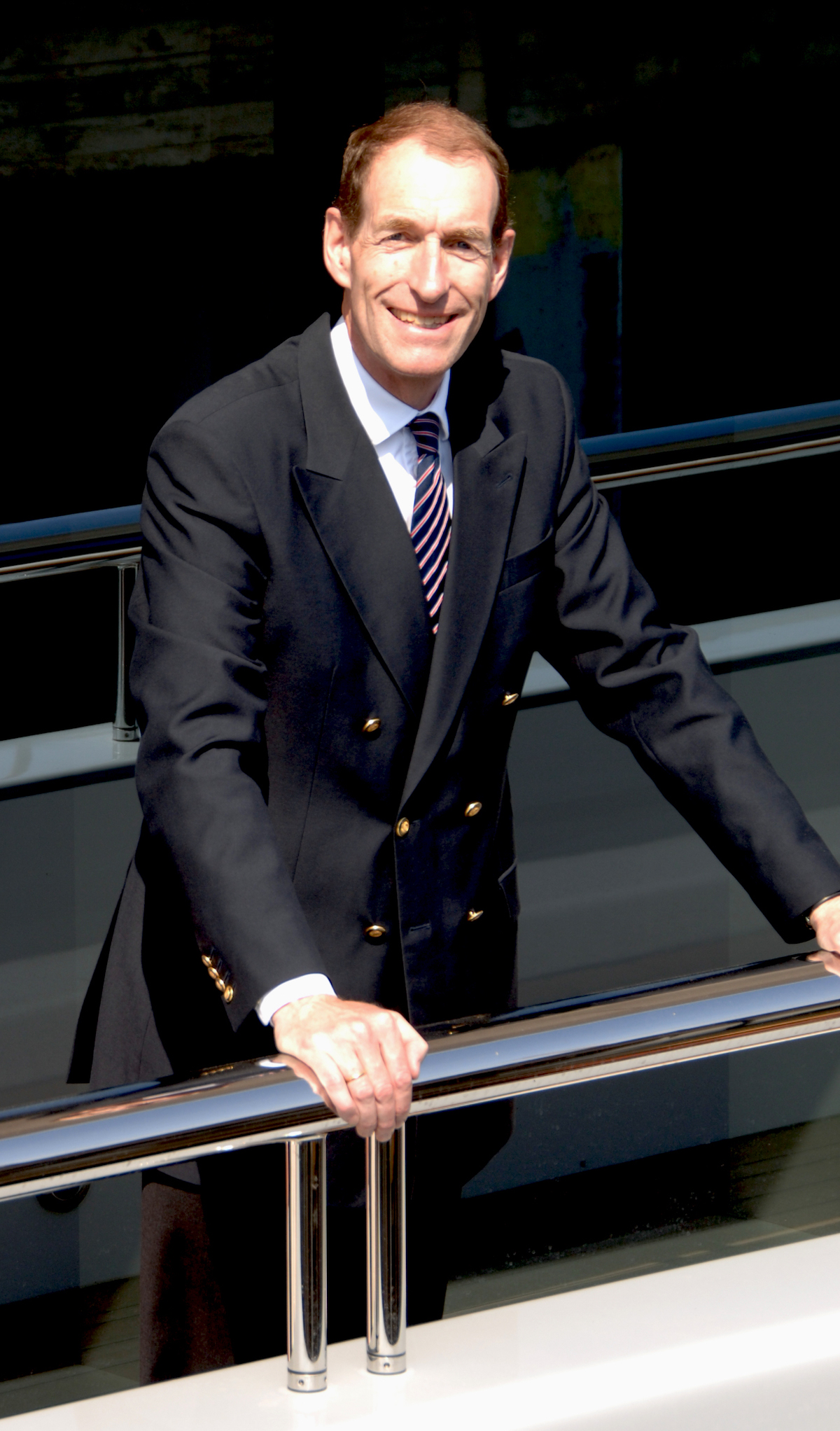
“With each individual project, for each individual client, we are building a dream.” – Holger Kahl
Today, the pre-eminent shipbuilder is a subsidiary of Privinvest, an international shipbuilding group. Germany’s Lindenau and German Naval Yards Kiel, France’s CMN, UK-based Isherwoods, and the multinational PISB are also part of the group. While Privinvest’s primary interest is naval shipbuilding, Nobiskrug is now its superyacht division.
Drawing upon its extensive experience, in the late 90s Nobiskrug turned to yacht building. Its inaugural project, the motor yacht Tatoosh was completed in 2000. “At the time, it was an absolute trendsetter,” recalls Holger. Meanwhile, owned by Microsoft co-founder Paul Allen, Tatoosh is still held in much reverence in the industry and remains high on the list of the largest yachts in the world. At 92.42 metres in length, it can accommodate 24 guests and 35 crew. Features include a swimming pool, cinema, 2 helicopter landing pads, and a diving room with decompression chamber (Paul is renowned for his diving capabilities).
“Since then, we have developed the brand Nobiskrug and have delivered quite the fleet of custom-built and award-winning superyachts,” Holger says. It has the capabilities to deliver yachts from 60 metres to over 400 metres. “Our biggest dock is 426 metres long,” he says, a fact that only serves to demonstrate his assertion that the yard is a long way off reaching the limits of what it is capable of achieving.
Both Nobiskrug’s facilities and expertise led to it winning what Holger refers to as “our actual masterpiece”: Sailing Yacht A. “All our yachts are masterpieces,” he continues, “but Sailing Yacht A is the biggest private sailing yacht in the world.” It was one of the most ambitious builds the yachting industry has ever contemplated, and Nobiskrug was one of the very few shipbuilders with the capabilities to undertake it. Sailing Yacht A shares the same owner as the similarly distinctive Motor Yacht A, both designed by celebrated French designer Philippe Starck.
While, as is common in an industry where discretion is paramount, many details of Sailing Yacht A are covered in a shroud of secrecy, the yacht is already the subject of much attention thanks to its size and unconventional design. As befits its position at the start of the alphabet, Sailing Yacht A leads the way in revolutionary engineering and design: a length of 143 metres; 3 carbon masts, the tallest in the world at over 90 metres in height each; 8 aft decks; and a fully customised hybrid diesel-electric propulsion. The yacht is due to be launched this year, and Holger is already contemplating the masterpiece that will follow. “It is a very special motor yacht that will offer a real wow factor in terms of optical design,” he explains, without divulging any more details.
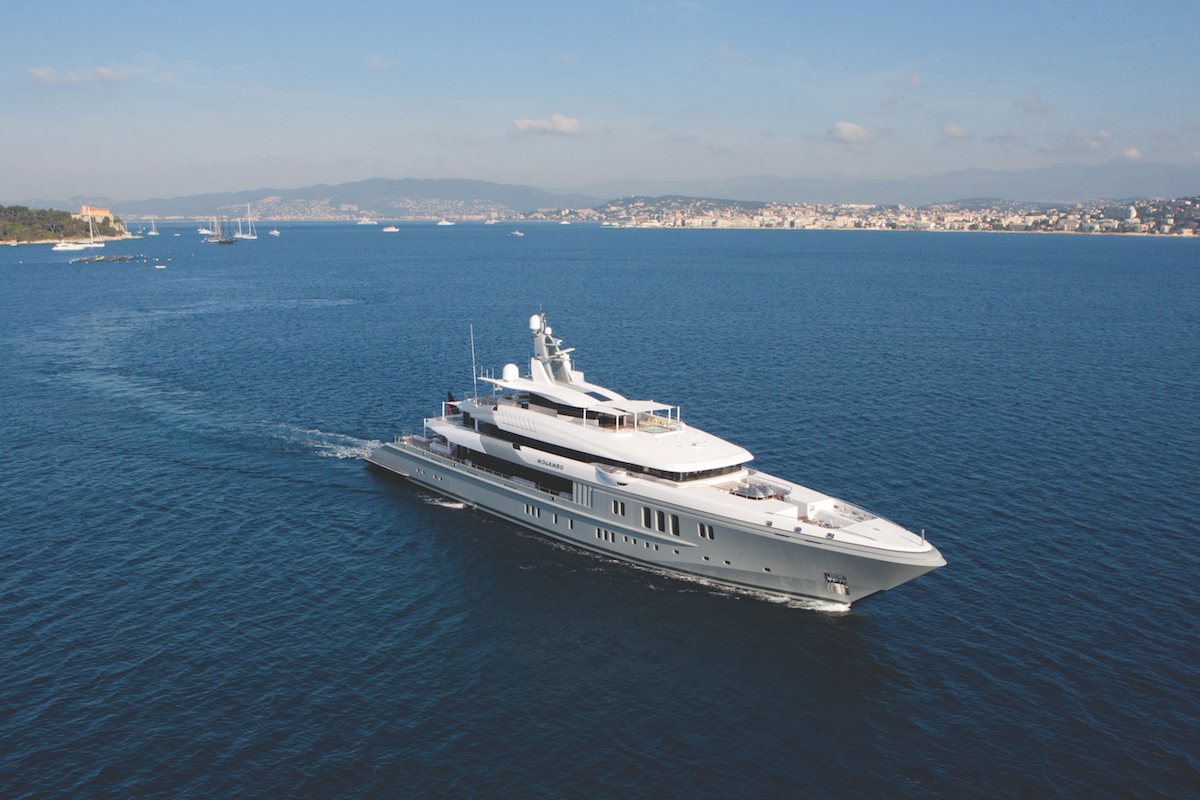
Since the year 2000, Nobiskrug has delivered a very select portfolio of custom-built yachts reflecting the company’s pledge to “concentrate on one single project for one single client,” as Holger phrases it. Not including projects currently under construction, the Nobiskrug fleet comprises 8 yachts in addition to Tatoosh: Triple Seven (2006), Siren (2008) , Sycara V and Jamaica Bay (2010), Sapphire (2011), Mogambo and Flying Fox (2012), and Odessa II (2013). Yachting enthusiasts will agree that it is one of the most admired fleets on the ocean today.
“We are not a mass yacht builder, nor do we want to be. We are not building a series. Our competitors may have many more yachts on their order books, but we want to build highly individual, customised superyachts that are timeless and reflect the vision of their owners.” He continues, “We want to concentrate on the client who will enjoy the engineering and the construction process. They should be involved, present, to see their product evolving, first on paper and then in steel. This is what we are focusing on.”
Holger acknowledges the influence the company’s experience in naval shipbuilding has on its yacht-building interests, and vice versa. “The system here is one that is balanced. It offers our clients a higher level of confidence about our technical and commercial capabilities,” he says, offering the example of the innovative propulsion systems developed for Sailing Yacht A, which will now be used in its next concept designs of frigates.
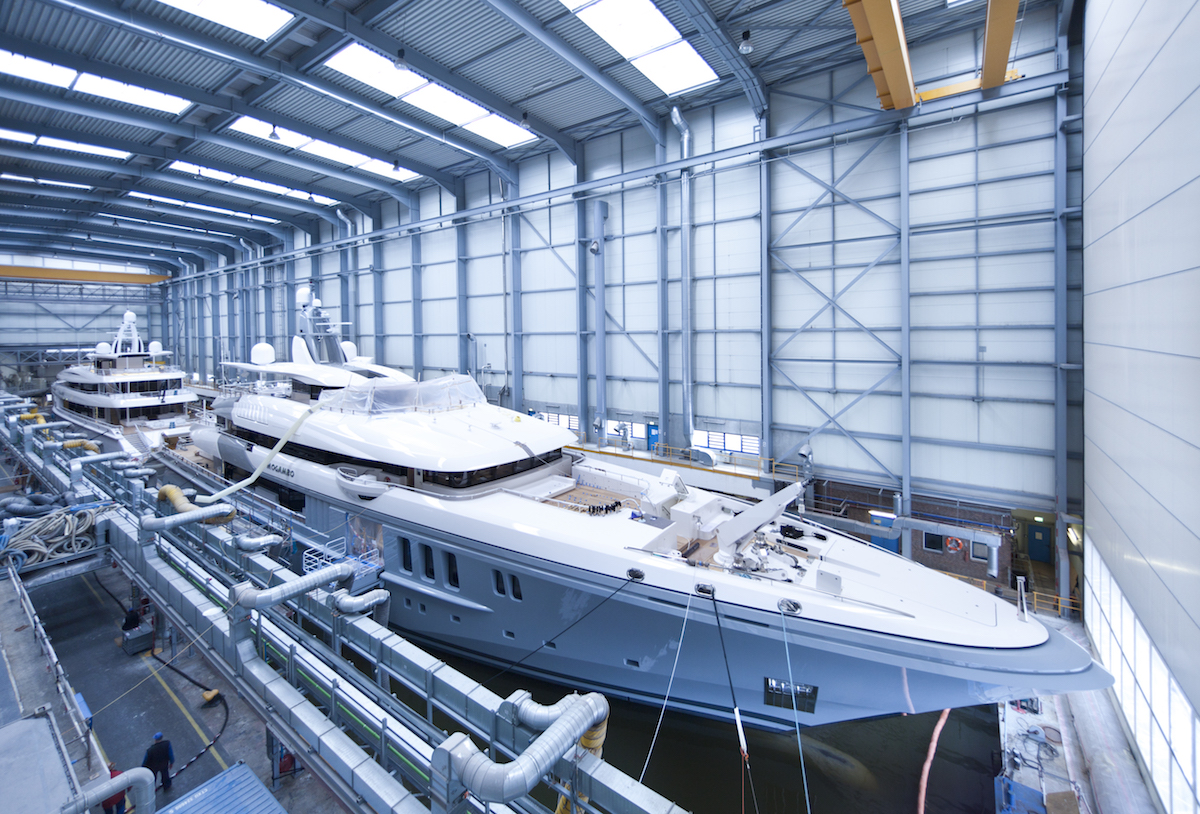
As the established shipbuilding centres in the Mediterranean and Northern Europe face increased competition from new players in the shipyard — less traditional countries such as Turkey, China and Brazil — the value of Nobiskrug’s heritage and fine German craftsmanship cannot be underestimated. “Many of our competitors come from boatbuilding, not shipbuilding, which is where we are coming from,” Holger emphasises. “They have experience in constructing small vessels and then try to break into the bigger vessels, by which I mean 60-metres-plus. Trying to get there this way is extremely difficult.” Instead, Holger believes the fact that Nobiskrug has come from a shipbuilding background offers substance. “We make real ocean-going vessels,” he says, “which are reliable in all the weather conditions imaginable.”
Innovation sparks in the yachting industry when visionary owners meet “technical magicians”, as Holger refers to his team of engineers and designers. Inspired features such as infinity pools, full-service spas, and foldable helipads have now become accepted standards in today’s new-build yachts thanks to the talented professionals who can convert dreams into reality. He acknowledges the challenges that lie in ensuring the aesthetic aspects of a design are seaworthiness and suitability for worldwide operation. “The safety of the owner, guests and crew is always paramount,” Holger says.
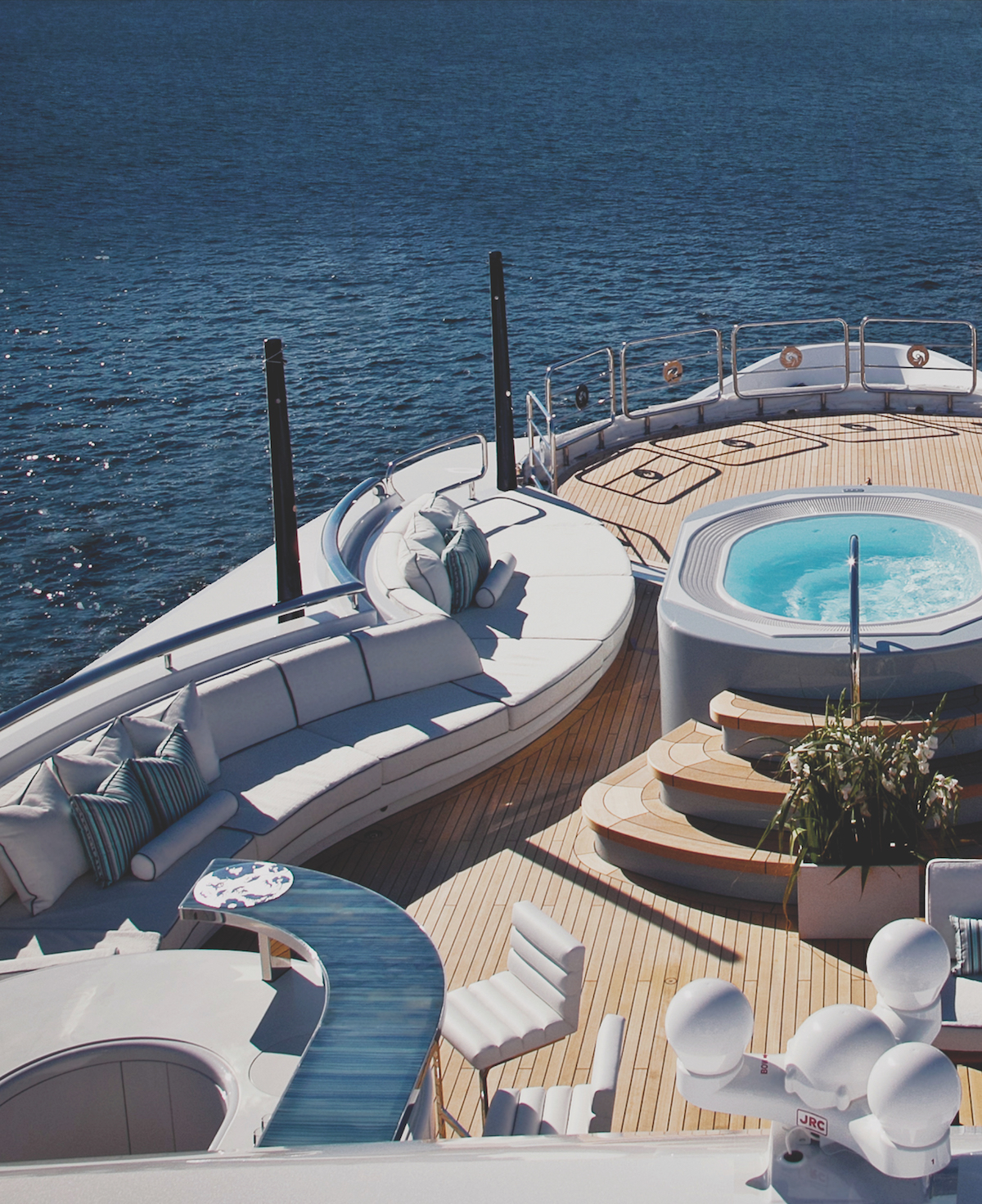
“The absolute focus for our engineers at the moment is to develop technologies to reduce the carbon footprint of our yachts.” – Holger Kahl
He enthusiastically identifies glass as one area where his team is making exciting advances. “I’m not talking about a simple window,” Holger says. “In our newest constructions, we are building structural glass areas.” Images released of Sailing Yacht A in yachting publications such as Boat International show twin glass bulwarks that, once installed, create an awe-inspiring curved underwater viewing platform. “For glass to have structural functions is something completely new in shipbuilding,” he says, explaining that the material had to be developed to comply with stringent Lloyd’s classification, the industry-standard register. “We needed approval for using the glass on the ocean, in every possible weather condition,” he says. Of course, the aesthetics had to be just right as well, a particular colour to match the appearance of the yacht and the luxurious interior. “As you can see, glass is not glass; it is a system, a really important system,” he concludes.
The past few years have also seen a commitment from many of the industry’s leading names to address the environmental impact of a yacht, from the exotic materials often used in an interior outfit to the carbon dioxide emitted into the atmosphere with each nautical mile travelled. Industry events, like the annual Monaco Yacht Show, offer a platform to unveil game-changing innovations such as fuel-optimising propulsion systems. “The absolute focus for our engineers at the moment is to develop technologies to reduce the carbon footprint of our yachts,” Holger says. “Some may be proclaiming the advent of the green yacht, but we technicians know that, in reality, the day a yacht is really green is a long way off. But to achieve all that we have today is fantastic and shows what is possible.”
Nobiskrug’s headquarters are located at Rendsburg, less than an hour from the border Germany shares with Denmark. The 180,000-square-metre yard boasts a waterfront location on the Eider River, just some metres away from the Kiel Canal, and is complemented by a larger 252,000-square-metre yard in the nearby city of Kiel. “It is a maximum of half an hour between our 2 sites, so we have a highly productive, integrated system here. Our people can easily move where they are needed,” says Holger. Measuring 160 metres in length, Nobiskrug’s climate-controlled superyacht hall at Rendsburg is the largest in the world.
“We are proud of all we have achieved based on our technical capabilities,” says Holger, acknowledging that much of Nobiskrug’s success can be attributed to its complete array of in-house competencies. “Our engineering department can approach any technical issue it is presented with, while our construction department includes ship building, piping, machinery, lathe, electrical and interior manufacturing workshops. We relish the challenges that are presented to us, the special ideas an owner or a designer may have, because we have the internal capabilities to approach them.”
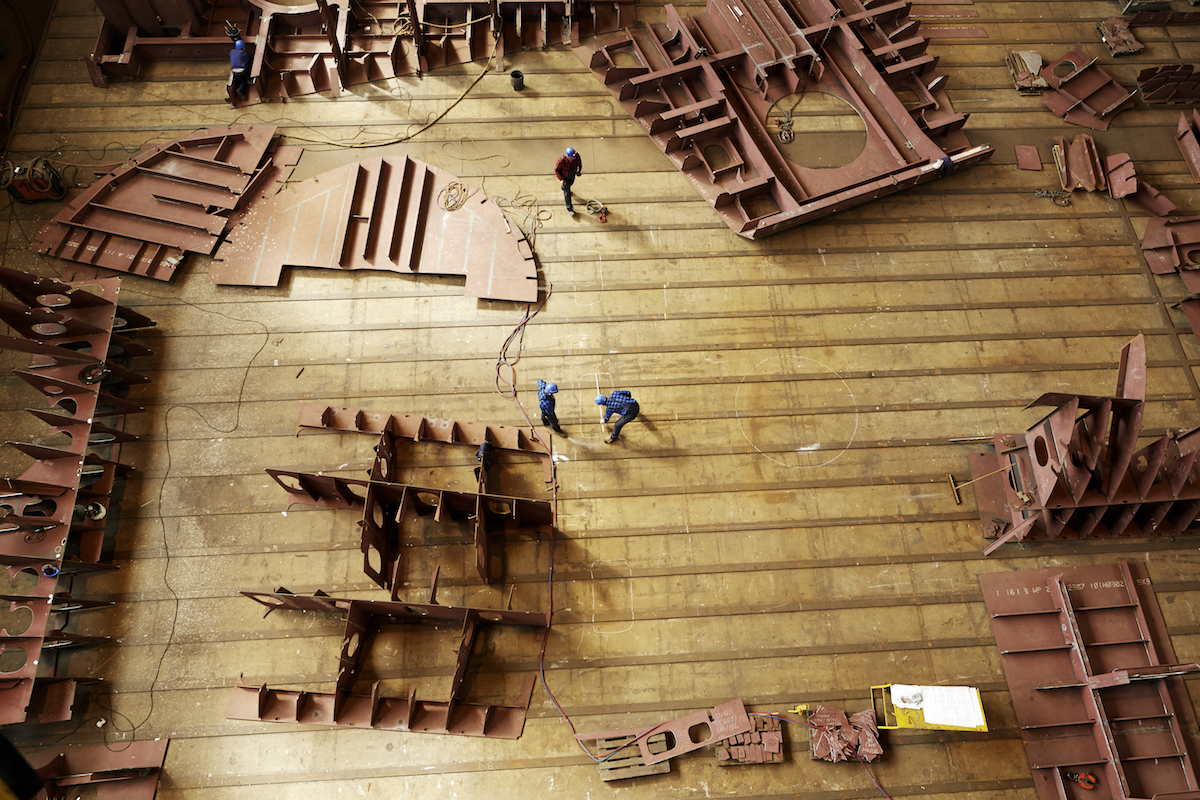
Triple Seven, delivered in 2006, was the first yacht to be built entirely under the Nobiskrug team. “Many cultures believe 7 is a lucky number, and that was definitely the case for us with this project,” says Holger. “The outer layers of the superstructure,
the non-structural elements that are the playground for designers to add curves and other aesthetic elements, were built from composite materials rather than aluminium, which is often the material of choice with other shipbuilders. Not only is it easier and lighter to install, but there is also less maintenance required once the yacht has been delivered,” he explains. “It was the first time that we were able to use the technology that we developed in house, and we are still further developing it today. It is very specific to Nobiskrug; no-one else is doing this to such an extent.” Where possible, his engineers try to avoid aluminium superstructures. “We believe the more materials you use, the more exposed to corrosion danger you are. We stick to structured steel, glass and composite materials.”
Certain aspects of the construction process, however, require subcontractor involvement, and a strong supplier network is crucial. Along with propulsion, Holger points to marine painters as one of the most important, as any deckhand who has had the pleasure of performing daily wash-downs of the superstructure and hull will agree. “The paint system in a yacht has to be perfect with respect to the various layers, from the undercoats which protect and conserve the steel up to the final top-coat layer, which is the optical effect that the owner sees.” Luxury-interior specialists are another. “The quality of furnishings must be to the highest standard. We’re not talking about a cruise ship; we are talking about a bespoke interior completely customised to the owner’s wishes, following the designer’s ideas,” Holger adds.
“Cooperation with suppliers is key,” he emphasises when asked about the importance of the relationships with his subcontractors. “We rely on them, and they rely on us. We have to maintain competition among our suppliers, but we also appreciate proven paths. The process is defined and a strictly controlled one, to assure the highest quality within the times and budgets agreed with the subcontractors. It is all part of our quality management system, which is of course certified by reputable institutions.”
Holger nominates the signing of each new contract and the launching of each new-build hull from the slipway into the water as highlights of his tenure as managing director. “Of course, the actual delivery to the owner is always such a proud moment too,” he continues. “We have had owners who have not only enjoyed the build process and frequently visited the yard during it, but they have also taken part in the delivery party with all the team. Such moments are real highlights for everyone in the yard!”
Each new project is undertaken with a highly customised approach. “We have fantastic concept proposals that can be merged with the ideas of the client, until the client is sure that the team has defined the superyacht that they really desire, without compromises,” Holger enthuses. Each project management team consists of yachting specialists: in planning, engineering, construction, and controlling. “This specialised team is fully dedicated to the project from early negotiations until launch. The result is a delivery that is on time, within budget, and of the highest quality.” He is quick to emphasise that the strictest confidentiality is assured. “From the start of the build through to the delivery, the owner only has one point of contact,” he says.
Nobiskrug’s mission statement is ‘Vision 22’, or “Superyachts for the twenty-second century,” as Holger explains it. “It is based on more than 100 years of experience. Some of the earliest yachts built at our yards still exist today, such as Sea Cloud 1, which was launched from Kiel as Hussar II in the 30s.” He names Talitha G and Haida G (now named Dona Amélia) as 2 other classics that stand out in the Mediterranean every summer season. “This is what drives us to look ahead, into the next century. What we build today will be statements for decades to come. I am sure that in more than 90 years, some of our recent yachts will still be in full use, offering their owners full enjoyment.”



